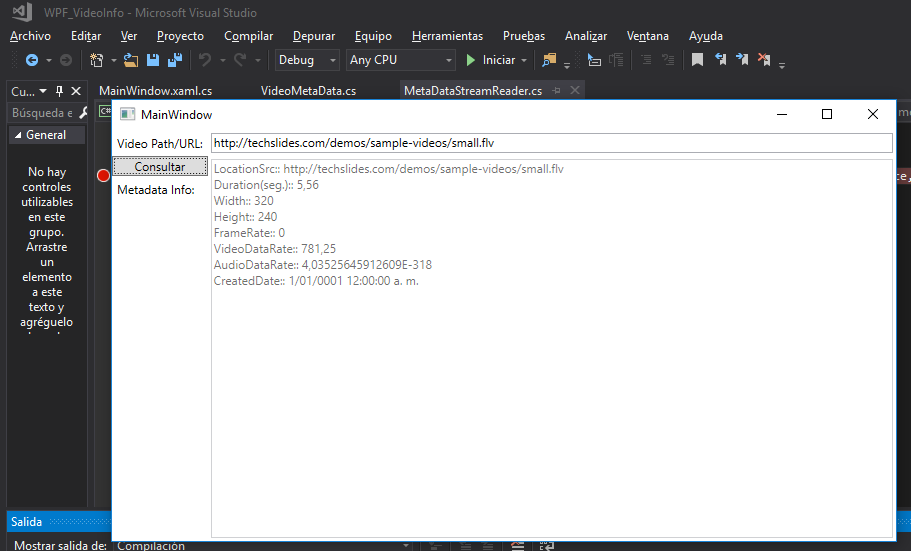Is there a code help to extract head information and target frames from flv file using C#?
Extract information from flv file using C# [closed]
Maybe this article can help you. It show how to read flv files and it's meta information in c#.
Basically, you have to open a binary file stream and read the first part of the file.
You have than to interpret bytes you read according to Adobe flv format specification. Anyway, the article has some code sample showing you how to read all header information.
Library for FLV/F4V conversation in C# .NET?
One of those libraries will probably help you.
While trying to use the accepted answer code I ended up doing this
using System;
using System.Collections.Generic;
using System.IO;
using System.Linq;
using System.Text;
using System.Threading.Tasks;
/// <summary>
///
/// [email protected]
///
/// </summary>
namespace VideoUtils.Impl
{
/// <summary>
/// Reads the meta information embedded in an FLV byte stream
/// </summary>
public class MetaDataStreamReader
{
/// <summary>
/// Reads the meta information (if present) in an FLV
/// </summary>
/// <param name="path">The path to the FLV file</returns>
public static VideoMetaData GetMetaDataInfo(MemoryStream memStream, string location)
{
bool hasMetaData = false;
double duration = 0;
double width = 0;
double height = 0;
double videoDataRate = 0;
double audioDataRate = 0;
Double frameRate = 0;
DateTime creationDate = DateTime.MinValue;
if(memStream == null)
{
throw new ArgumentNullException("Parameter MemoryStream is null");
}
try
{
// read where "onMetaData"
byte[] bytes = new byte[10];
memStream.Seek(27, SeekOrigin.Begin);
int result = memStream.Read(bytes, 0, 10);
// if "onMetaData" exists then proceed to read the attributes
string onMetaData = ByteArrayToString(bytes);
if (onMetaData == "onMetaData")
{
hasMetaData = true;
// 16 bytes past "onMetaData" is the data for "duration"
duration = GetNextDouble(memStream, 16, 8);
// 8 bytes past "duration" is the data for "width"
width = GetNextDouble(memStream, 8, 8);
// 9 bytes past "width" is the data for "height"
height = GetNextDouble(memStream, 9, 8);
// 16 bytes past "height" is the data for "videoDataRate"
videoDataRate = GetNextDouble(memStream, 16, 8);
// 16 bytes past "videoDataRate" is the data for "audioDataRate"
audioDataRate = GetNextDouble(memStream, 16, 8);
// 12 bytes past "audioDataRate" is the data for "frameRate"
frameRate = GetNextDouble(memStream, 12, 8);
// read in bytes for creationDate manually
memStream.Seek(17, SeekOrigin.Current);
byte[] seekBytes = new byte[24];
result = memStream.Read(seekBytes, 0, 24);
/*
string dateString = ByteArrayToString(seekBytes);
// create .NET readable date string
// cut off Day of Week
dateString = dateString.Substring(4);
// grab 1) month and day, 2) year, 3) time
dateString = dateString.Substring(0, 6) + " " + dateString.Substring(16, 4) + " " + dateString.Substring(7, 8);
// .NET 2.0 has DateTime.TryParse
try
{
creationDate = Convert.ToDateTime(dateString);
}
catch { }
*/
}
}
catch (Exception )
{
// no error handling
}
finally
{
if (memStream != null)
{
memStream.Close();
}
}
return VideoMetaData.CreateFlvMetaInfo(hasMetaData, duration, width, height, videoDataRate, audioDataRate, frameRate, creationDate, location);
}
private static Double GetNextDouble(MemoryStream memStream, int offset, int length)
{
// move the desired number of places in the array
memStream.Seek(offset, SeekOrigin.Current);
// create byte array
byte[] bytes = new byte[length];
// read bytes
int result = memStream.Read(bytes, 0, length);
// convert to double (all flass values are written in reverse order)
return ByteArrayToDouble(bytes, true);
}
private static string ByteArrayToString(byte[] bytes)
{
string byteString = string.Empty;
foreach (byte b in bytes)
{
byteString += Convert.ToChar(b).ToString();
}
return byteString;
}
private static Double ByteArrayToDouble(byte[] bytes, bool readInReverse)
{
if (bytes.Length != 8)
throw new Exception("bytes must be exactly 8 in Length");
if (readInReverse)
Array.Reverse(bytes);
return BitConverter.ToDouble(bytes, 0);
}
}
}
© 2022 - 2024 — McMap. All rights reserved.

